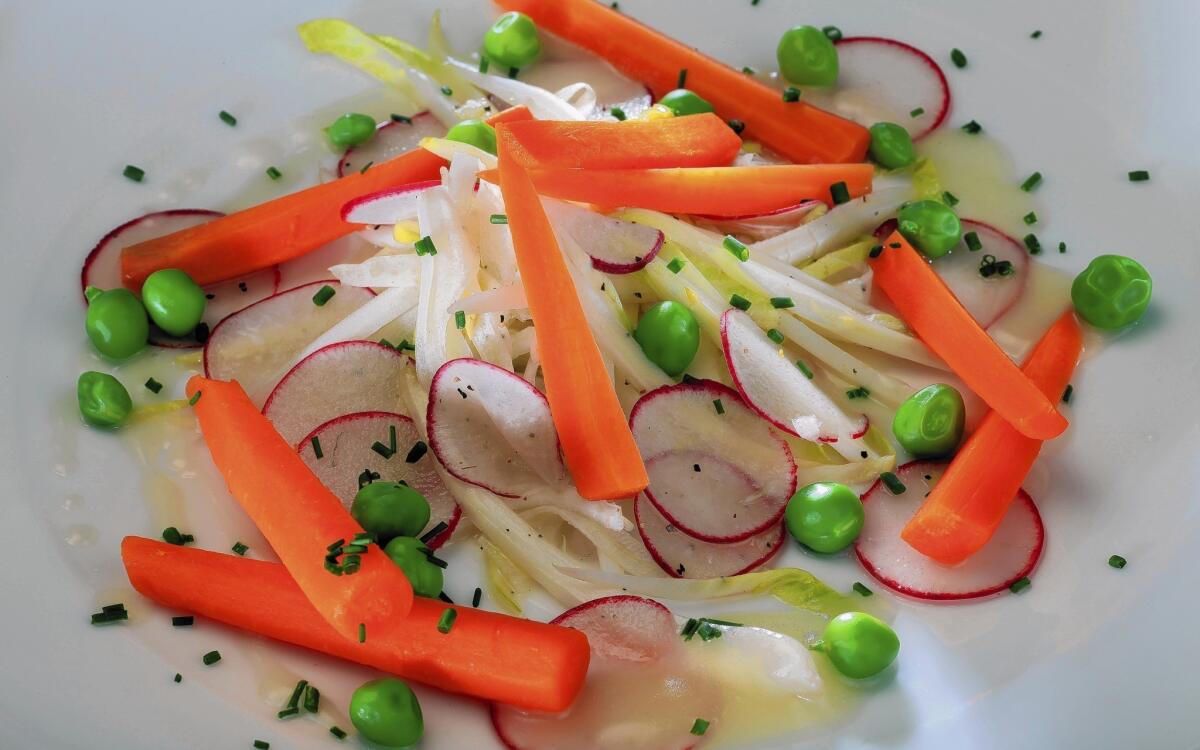Spring vegetable salad with l'Arpege's aigre-doux

We go to great restaurants for magic, for an extraordinary experience that is beyond our reach as home cooks. And so how to explain that the single most memorable dish I had at Alain Passardās Michelin three-star restaurant lāArpege in Paris was a salad, and one that you could make quite easily at home?
Passard is undoubtedly a culinary magician, but of a decidedly subtle sort. Rather than creating elaborate constructions, his gentle touch coaxes out flavors that can change the way we look at ingredients.
Particularly at this time of year, when the markets are lined wall-to-wall with some of the best fruits and vegetables youāll ever taste, this is the kind of cooking that resonates.
And so, yes, Passardās guinea fowl roasted in hay was spectacular, and so was the slow-cooked turbot. But the dish that I havenāt been able to get out of my mind was an assortment of spring vegetables served with a sweet-sour dressing he calls aigre-doux.
There was a bit of beet, a couple of slender carrots, silken leaves of cooked onion, thin slices of cucumber and a few stray leaves of various greens. Simple, right? Yet it perfectly captured on a plate that exact moment of spring.
Each element tasted so clearly and deeply of itself that it seemed like it must have been some kind of magic. In reality, of course, there was no hocus-pocus, just perfect technique, and a little bit of that sublime sauce, which seems to amplify the flavors of everything it touches.
And hereās the best part: If youāve got an immersion blender, you can make that aigre-doux quite easily at home. In fact, you probably have all the ingredients in your cupboard. Blend honey and acid until smooth, and then slowly trickle in oil until the sauce has a consistency somewhere between heavy cream and mayonnaise.
You can vary the dressing by using different acids ā substitute lime for lemon, or sherry vinegar for Champagne. And experiment with different oils. Unless itās a mild Provencal-style, straight olive oil might be a bit too strong; cut it with neutral vegetable oil.
Iāll be the first to admit that this isnāt my usual style of cooking. Iām much more comfortable with salads piled on platters than this kind of intricate ikebana type of plating. But Iāve also got to admit that it is growing on me in a kind of shocked āwow, did I really make that?ā kind of way.
A couple of important things Iāve learned: With a dish this simple, every ingredient has to be perfect or you wind up looking like a jerk; thereās a thin line between artistry and pretension. Make sure each element is of the best quality and cooked just to the exact point. And remember that less is more; you donāt want a heap of ingredients piled on a plate, just enough to make your point.
Though it seems like it couldnāt be more different, a great cobbler works the same way. Think about it: Perfect seasonal fruit complemented by a simple, endlessly mutable uniting element.
A cobbler topping comes together in just a couple of minutes. Itās basically just a cream biscuit dough that you drop by large spoonfuls on top of the fruit before baking. If youāve got great berries, flavor the dough with orange zest or slivered basil. If youāve got peaches or nectarines, maybe chop in almonds or minced fresh ginger. You get the picture.
Itās simple enough ā an everyday kind of magic when you compare it to a meal at a three-star restaurant. But sometimes thatās all thatās necessary.
Follow me at @russ_parsons1
In a small bowl, blend the honey, white wine vinegar and lemon juice with an immersion blender. With the blender running, slowly add the olive and vegetable oils, blending until you have a smooth sauce with a consistency somewhere between heavy cream and loose mayonnaise. You will have more dressing than required for the recipe; the remainder will keep tightly covered in the refrigerator for several days (just blend briefly before using it).
Cook the whole peeled carrots in a large pot of rapidly boiling, generously salted water until just tender-crisp, about 4 minutes. Refresh in an ice bath to stop cooking, pat dry and, if they are big enough, cut them into lengthwise quarters. Cook the peas in the same pot of water, refresh in an ice bath and pat dry.
Quarter the fennel, cut out the solid core and slice it lengthwise as thin as you can. Collect it in a large work bowl. Slice the radishes as thin as you can crosswise and add them to the work bowl. Quarter the heads of endive lengthwise, cut out the solid core and cut the leaves into thin strips. Add to the work bowl and set aside.
When ready to serve, blend the dressing briefly to recover the consistency. Spoon a generous tablespoon of the sauce in the center of a salad plate and use the back of the spoon to carefully spread it in a circle. Lightly season the shaved vegetables with salt and pepper and arrange over the top of the dressing in an attractive pattern (this must be done at the last minute or the salt will soften the vegetables).
Drizzle a half-teaspoon or so of dressing over the shaved vegetables and arrange the carrots and peas over the top. Sprinkle with minced chives and serve immediately.
Get our Cooking newsletter.
Your roundup of inspiring recipes and kitchen tricks.
You may occasionally receive promotional content from the Los Angeles Times.
















